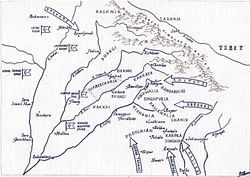This article needs additional citations for verification .(January 2017) |
Singhpuria Misl ਸਿੰਘਪੁਰੀਆ ਮਿਸਲ Singhpurī'ā Misal | |||||||||||||
|---|---|---|---|---|---|---|---|---|---|---|---|---|---|
| 1733–1816 | |||||||||||||
 Faizulpuria Misl within the Sikh Confederacy | |||||||||||||
| Capital | Jalandhar | ||||||||||||
| Common language | Punjabi | ||||||||||||
| Religion | |||||||||||||
| Misldar | |||||||||||||
• 1733–1753 | Kapur Singh | ||||||||||||
• 1753–1795 | Khushal Singh | ||||||||||||
• 1795–1816 | Buddh Singh | ||||||||||||
| Historical era | Early modern period | ||||||||||||
• Established | 1733 | ||||||||||||
• Disestablished | 1816 | ||||||||||||
| |||||||||||||
| Today part of | |||||||||||||
| Misls of the Sikh Confederacy |
|---|
 |
Singhpuria Misl, also known as the Faizulpuria Misl [1] , was one of the twelve misls of the Sikh Confederacy. [2] It founded by the Sikh warrior Nawab Kapur Singh, who was born in1697 and later became a prominent Dal Khalsa leader. [3] The misl took its original name from a village Faizullapur in Amritsar and then changed the name of the village to Singhpura, with the misl eventually following.[ citation needed ]

